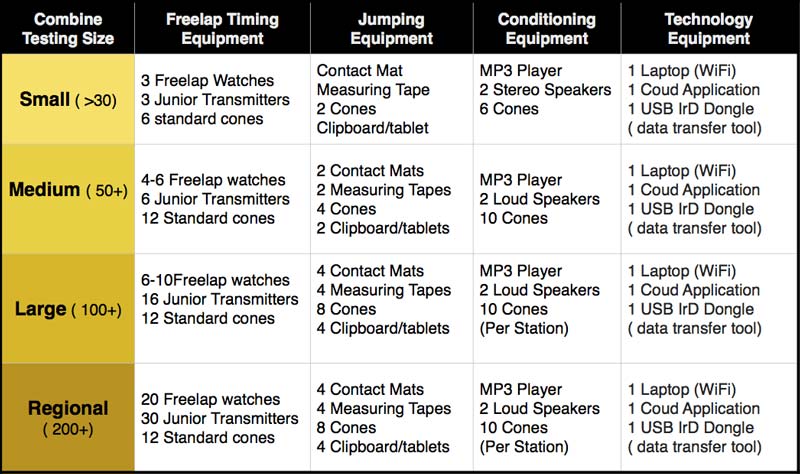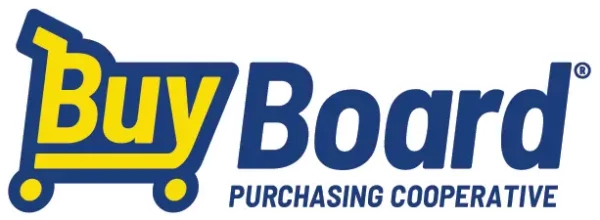
By Carl Valle
Many private facilities and high schools are realizing that several problems can be solved by hosting a sport specific combine or general performance combine like the NFL and MLS invites. Not only is the combine a great way to showcase performance ability for athletes, but it’s a great way to get everyone involved in the training and preparation process in the area. A good combine can make a good profit for fundraising, be tasteful marketing for private facilities, and get parents an eye opening experience to what an athlete can do athletically. Finally, athletes themselves can get the needed objective feedback of their general talents to see how they can be better on the field or court.
Logistics, Equipment, Staff, and Promotional Needs
When getting started, it should be noted it takes months of lead time for people to plan to go to any combine. The speed of social media is fast, but dates must meet the scheduling of the scholastic calendar or simply athletes will not come. Many clubs, facilities, and teams include college coaches or third party scouting services to help drive interest, but showcases or games sometimes become too complicated to execute as it usually turns into a pick-up game instead of something more indicative of an athlete’s ability. A combination of testing and teaching pairs naturally, and adding splitting up the morning and afternoon sessions can help those that attend choose both or pick the combine only if they are looking at analysis. No matter what you choose, a minimum of 3 months should be planned out as it allows enough preparation time for you to host it as well as enough time for parents to plan ahead as they are the ones likely to be paying.
1. The Legal and the Business Side
The most important need is going to be getting a good waiver and a price point that will attract the best athletes while making a profit. If you are renting out a facility you need to do a big lead time but don’t worry, many combines are paid marketing if done properly. Even if the combine breaks even or loses a little money, the contact with athletes and parents is very useful for showing parents and athletes what you provide with face time and their contact information. A good T-shirt with Nike like material is the best choices as cheap white T-shirts are never worn after by athletes, but grey or black are popular training shirts as well as just all around options. Nothing beats walking advertisement of your combines by the athletes who are participating.
2. What Tests To Perform
The most obvious question is what to include for testing now that the metric system is starting to creep into American sports. We will always have 40 and 60 yard dashes and have those tests in stances specific to Football and Baseball, but some progressive coaches are starting to get meters and shorter distances with splits. One Option is to get a combination of short metric splits and final imperial time so that the coaches have the real data they need and still provide the legacy data the parents and athletes want, such as their 40 yard dash times. While a little strange, the combination timing option is very helpful for training down the road and still keeps interest in the tests performed. Other tests like the classic 5-10-5 can still be used in yards or converted into meters for soccer, a sport that is more international. Basketball is a little less concrete and it’s really important for coaches in the US to include both conversions if possible. Most combines include jump tests such as vertical jumps and broad jumps (horizontal Jumps) and it’s better to include just vertical jumps if dealing with a population that may not be used to the landing of standing broad jumps. Some academies in the US are Canada are doing Squat Jumps versus counter movement jumps (no arms) to get more insight, but not all coaches have contact mats. Tools like the Just Jump Mat, Gymaware, and Optojump are growing. Endurance tests should be included for soccer athletes if requested, but don’t make it mandatory as the Yo-Yo Intermittent Recovery tests are not as enjoyed as sprint and jump assessments. Include them as some may wish to see their abilities if they are not blessed with speed, and many coaches like to see what athletes are like when fit, since it’s easy to be fast when no endurance requirements are present.
3. Staffing Size, Schedule, and Equipment Ratio
What takes only seconds to perform takes hours to assess with even the most organized people. Everything that can go wrong sometimes will pop up, but the best option is to take 1 minute per test per athlete. If the testing runs smooth you can give formal water breaks and make sure you review the instructions to keep from athletes from getting rushed through. Most power tests want to be run fast enough not to cool off but not too fast they become conditioning routines. Lines are OK to have provided they are not more than 10 minutes and it’s better to run multiple stations of the same test and let people take rest periods than to have a giant bottleneck and look like one is at Disney World at peak season. No perfect formula exists, but here is an outline. I like to have a 1:10 ratio of coaches to athlete as it’s hard to manage athletes that have needs when you are actually doing another job. For every assigned staff person, one floater should be doing loose ends and keeping people moving along. You will need one person running the test and one data collector per station.

4. Promoting Your Combine
Depending on your area, a coach can be either speaking to parents and coaches new to testing or be in a heated battle with other facilities doing the same thing. When it comes down to testing choose a time that is between seasons and always before the summer as most facilities work with scholastic athletes in the late middle school to high school age. Promotion will work with social media solutions like Facebook pages and direct athlete to athlete connections, but some footwork and calling is needed. Each year hosting the same time solidifies your time slot and athletes get use to participating. A quality mini poster can be made at professional levels with Microsoft Office when really good stock photos are the backgrounds. Like the T-Shirts, you are only as good as you look so buy from Shutterstock and other sites that have large size images that look professional and are inexpensive. Don’t use white backgrounds and print at a professional shop. Contact team coaches and email them the PDF and follow up with an actual visit if you can.
5. Marketing Your Team and Services
The experience and hospitality of your combine will be the first impression to parents and athletes new to combines, new to your club or team, or new to your profession. When things run smooth people want to get involved, but if things run a little bumpy it sometimes can expose you if you are not prepared. No matter what happens at the combine it’s important that everyone is acting prepared and have one person to help manage the parents and athletes on the sidelines if they are close to the performance area. A coach or person that has a strong voice and leading ability should be guiding and instructing the athletes to follow directions. After the combine is complete showcase the results in a quality report of one to three pages so parents know what the test is, what it assesses, and how the athlete did. Included should be how the team or facility provides ways to improve those abilities with training, not just improve the times and distances.
6. Dress Rehearsal or Dry Run
Workflows and efficiency evolves each year, but experience in using the equipment during practice is better than any singular dress rehearsal. With people that are paying for combine results, you want to make sure you do one practice run by actually getting out the equipment and doing a mock combine a week before just in case something is missing and you need a few more miscellaneous items. Murphy’s Law is that the practice will go either smoothly and something random will show up, or the practices have glitches and things are smooth sailing later at the combine. Don’t do one or two tests but try to see what happens with a group of five or more line up. The purpose of the practice is to see how much waiting one has and what happens when people are out of line for bathroom breaks, someone wants to try again if they slip a bit, and other common things that pop up.
Closing Thoughts on Hosting a Combine
Remember the purpose of the combine is to provide a service and make testing a little more like a party than punishment. Just simple jumping and sprinting is a chance for athletes to remove the tactical elements or game restrictions and just perform. Doing a combine right should feel upbeat and positive so athletes can improve their scores individually. A healthy balance is to provide enough spacing and distance from the test results so athletes have privacy but play music or be motivational to each attendee. Sport should feel fun and testing doesn’t have to be like the SATs or final exams. A good combine run well can raise money for equipment, travel costs, or provide marketing to great training facilities that are not caught up in the hype style marketing.
Please share this post so others may benefit.
[mashshare]


Hi Carl,
Do you know of any outfit that offers a software platform that can handle all the data input from combine events? Something that offers customization, ranking, etc. of the events…
We have used Excel spreadsheets here but I’m looking for something more polished that is not so temperamental to being corrupted during the data entry process.
Thanks,
Crosby Tajan
Powell Middle School
Powell, WY